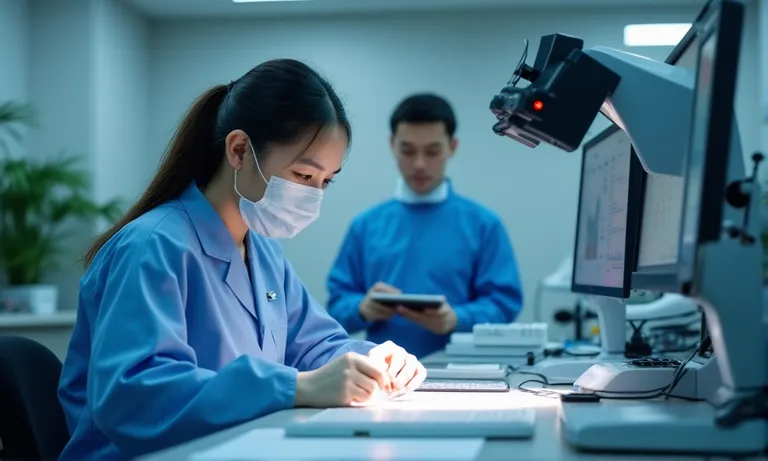The quality standards that matter most when working with a Chinese dental lab are those that are globally recognized, structurally embedded, and practically verifiable. Certifications like ISO 13485, FDA, and CE signal regulatory alignment, while internal quality control systems and transparent documentation practices determine whether a lab is truly ready for long-term collaboration.
Buyers evaluating Chinese lab partners should focus on three key areas:
certification validity to confirm compliance with international manufacturing and material safety expectations;
quality assurance processes such as material traceability, multi-stage inspection, and pilot case evaluation;
and operational transparency, including documentation access, rework terms, and structured communication during onboarding.
When these elements are visible, measurable, and proactively shared, they don’t just confirm quality—they lay the groundwork for scalable, dependable cooperation.
Which International Certifications Define Dental Quality?
For overseas buyers evaluating Chinese dental labs, international certifications serve as critical signals of process discipline and regulatory alignment. These certifications don’t guarantee perfection, but they do offer a standardized way to assess whether a lab is structured for repeatable, compliant, and auditable production. Among the most widely recognized frameworks are ISO 13485, FDA clearance, and CE marking—all of which contribute to a buyer’s ability to evaluate risk and ensure delivery consistency.

ISO 13485: The Foundation of Quality Management in Dental Manufacturing
ISO 13485 sets the global benchmark for quality management systems in medical device manufacturing, including dental restorations. Labs operating under this certification follow documented protocols for every stage—from case intake and material handling to fabrication, inspection, and delivery.
What this means for buyers:
- Internal SOPs govern each production step
- Nonconformities and corrective actions are tracked and logged
- Periodic internal audits and third-party surveillance are required
- Batch-level material traceability is maintained
Labs with ISO 13485 in place are equipped to manage complexity at scale. For buyers, this translates to better documentation, more predictable quality, and structured pathways for issue resolution.
Labs like Raytops that serve export-driven markets often share audit summaries and key quality procedures to align with clients’ internal compliance requirements during onboarding.
FDA and CE: Material Compliance and Market Readiness
In addition to quality systems, buyers must also verify that the materials used—such as zirconia discs, metal frameworks, and cementing agents—meet the regulatory requirements of their target market. This is where FDA clearance and CE marking come into play.
Key checkpoints include:
- Whether materials are FDA-cleared (for U.S.) or CE-marked (for EU)
- Whether lab partners can trace materials back to certified manufacturers
- Whether safety data sheets and declarations of conformity are readily available
Compliance documentation isn’t just paperwork—it enables clinics, DSOs, and distributors to meet their own regulatory responsibilities downstream. Chinese labs that operate internationally often embed documentation handoff and traceability into their standard delivery process, minimizing the administrative burden on buyers while maintaining transparency.
How to Assess a Lab’s Internal Quality Control?
Certifications demonstrate that a lab meets certain standards—but internal quality control is where consistency truly takes shape. For buyers evaluating potential lab partners, understanding how quality is managed on the production floor is essential. From how materials are tracked to how finished restorations are inspected, a transparent, layered quality process signals readiness for long-term cooperation.

From Material Traceability to Multi-Stage Inspection
A structured lab quality system manages both input risk and output consistency. Mature dental labs implement layered checkpoints to reduce variation and catch issues before delivery.
Key components include:
- Material traceability: Every disc, alloy, or ingot is recorded by lot number, supplier, and production batch. This ensures compliance and enables quick recalls if needed.
- Work-in-progress tracking: Each case has a unique identifier that moves through digital checkpoints at CAD design, framework, ceramic, and final finish stages.
- Multi-stage inspection: Technicians review margins, contacts, and aesthetics before shipping, with final QA typically done under calibrated lighting by a dedicated team.
- Issue logging and root cause tracking: Errors and remakes are logged, categorized, and reviewed regularly to improve upstream processes.
Labs that export at scale often share a summary of their QA framework during early-stage collaboration, allowing buyers to understand how quality is managed at each touchpoint. Labs such as Raytops, which operate with multi-market compliance requirements, typically provide buyers with inspection checklists and traceability logs as part of the onboarding kit. This transparency gives clinics and DSOs greater visibility—and confidence—before full-scale onboarding.
How to Use Trial Orders to Evaluate Quality in Practice
Even with robust documentation, the most reliable way to evaluate a lab is to observe how it performs under real case conditions. A well-designed trial phase gives buyers direct insight into communication responsiveness, production quality, and adjustment rates.
Key steps in an effective pilot include:
- Start with 3–5 common indications (e.g., posterior monolithic crowns, anterior layered zirconia, full metal bridges)
- Request technical parameters upfront: cement space, contact tightness, occlusion setup, etc.
- Establish case review checkpoints: joint evaluation of margin fits, esthetic outcomes, and chairside adjustment records
- Track remake and revision rates over 2–3 batches, including cause categorization
Many overseas buyers use trial orders not only to confirm technical quality, but also to evaluate file handling, turnaround predictability, and communication rhythm. Some export-focused labs, including Raytops, support pilot orders with technician pairing, digital calibration, and progress tracking—helping buyers establish confidence without committing prematurely. This structured trial phase is where trust begins to form—not from marketing, but from execution.
What Signals Operational Transparency and Partnership Readiness?
In cross-border lab partnerships, technical capability is only part of the equation. Buyers also need confidence that their partner is willing—and equipped—to share the right information at the right time. Operational transparency turns uncertainty into structure, and gives procurement teams the visibility they need to make consistent decisions.
Requesting Certification and Compliance Documentation
Before entering a long-term relationship, buyers often request access to supporting documents that validate both process and material compliance. Labs with established export systems typically maintain ready-to-share files as part of their onboarding workflow.
Common documentation includes:
- Valid ISO 13485 certificate, with issue and renewal dates from a recognized notified body
- Supplier-origin documentation for zirconia, alloys, PMMA, and other key materials
- FDA 510(k) or CE declaration for relevant source materials
- Material safety data sheets (MSDS) and conformity statements
- Process overviews such as production flowcharts, inspection checkpoints, and nonconformance handling
This isn’t just about due diligence—it’s about establishing a shared quality baseline. Labs that proactively provide documentation show a clear intention to align with buyer compliance systems, not just sell a unit.
Labs working with regulated markets like the U.S., EU, or Middle East often tailor their document packages to local authority expectations. Raytops, as an export-focused lab, routinely aligns its document structure with buyer-side QA protocols, including ISO summaries and CE-origin material reports. Documentation sharing is integrated into early-stage coordination—not as a favor, but as a default part of the process.
Building Confidence Through Clear Rework and Support Policies
Even with strong QA systems in place, occasional remakes or adjustments are a normal part of production. What separates a dependable lab from a risky one is not perfection, but how clearly and consistently post-case issues are managed.
Buyers should seek transparency on:
- Rework conditions: when it’s accepted, turnaround time, and documentation required
- Adjustment windows: how long after delivery rework will be honored
- Support structure: who handles issue resolution, and whether there’s a consistent point of contact
- Case data retention: how long the lab keeps STL files, Rx forms, or shade maps for referencing
When these policies are formalized, it reduces the friction of handling exceptions and builds confidence that the lab is prepared to support—not deflect—when issues arise.
Labs focused on partnership longevity often include rework terms in their SOP or client onboarding documents. Instead of waiting for buyers to ask, they frame these as part of their service commitment. Raytops incorporates these terms into the front end of each engagement, allowing both sides to manage expectations and reduce downstream negotiation. That small structural difference creates a major perception shift: from “supplier” to “partner.”
Choosing a reliable dental lab isn’t just about finding competitive pricing—it’s about ensuring that every crown or bridge is backed by a system built for quality, traceability, and accountability. For overseas buyers, especially those considering Chinese partners, the ability to verify certifications, assess internal quality protocols, and understand how a lab handles rework or documentation is what transforms uncertainty into confidence.
Strong labs don’t just manufacture—they communicate, document, and support. They operate under global frameworks like ISO 13485, work with FDA- and CE-compliant materials, and offer buyers visibility into production flow, material sourcing, and support policies.
For buyers evaluating labs in China, transparency is not a luxury—it’s a foundation. When certifications are verifiable, quality control is structured, and after-sales processes are documented, partnerships are easier to scale and maintain.
At Raytops, we work alongside clients to align these systems early—so that what begins as due diligence becomes the basis of long-term trust.


